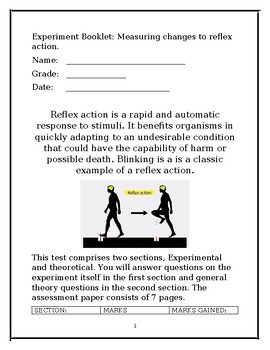EXPERIMENT BOOKLET MEASURING CHANGES TO REFLEX ACTION
syeblues education
2 Followers
Resource Type
Standards
CCSSRST.9-10.1
CCSSRST.9-10.2
CCSSRST.9-10.3
CCSSRST.9-10.4
NGSSHS-LS1-2
Formats Included
- Word Document File
Pages
10 pages
syeblues education
2 Followers
Description
Experimental booklet description:
This assessment booklet covers the topic of measuring the reflex action in our bodies. Questions are also related to nerves and the reflex arc. An experiment is explained, and questions asked regarding the experimental procedure and the theory behind it.
The assessment is allocated forty marks spread over two sections.
The questions vary in ability level and style.
A full mark scheme is included.
Total Pages
10 pages
Answer Key
Included
Teaching Duration
1 hour
Last updated 5 months ago
Report this resource to TPT
Reported resources will be reviewed by our team. Report this resource to let us know if this resource violates TPT’s content guidelines.
Standards
to see state-specific standards (only available in the US).
CCSSRST.9-10.1
Cite specific textual evidence to support analysis of science and technical texts, attending to the precise details of explanations or descriptions.
CCSSRST.9-10.2
Determine the central ideas or conclusions of a text; trace the text’s explanation or depiction of a complex process, phenomenon, or concept; provide an accurate summary of the text.
CCSSRST.9-10.3
Follow precisely a complex multistep procedure when carrying out experiments, taking measurements, or performing technical tasks, attending to special cases or exceptions defined in the text.
CCSSRST.9-10.4
Determine the meaning of symbols, key terms, and other domain-specific words and phrases as they are used in a specific scientific or technical context relevant to grades 9–10 texts and topics.
NGSSHS-LS1-2
Develop and use a model to illustrate the hierarchical organization of interacting systems that provide specific functions within multicellular organisms. Emphasis is on functions at the organism system level such as nutrient uptake, water delivery, and organism movement in response to neural stimuli. An example of an interacting system could be an artery depending on the proper function of elastic tissue and smooth muscle to regulate and deliver the proper amount of blood within the circulatory system. Assessment does not include interactions and functions at the molecular or chemical reaction level.





